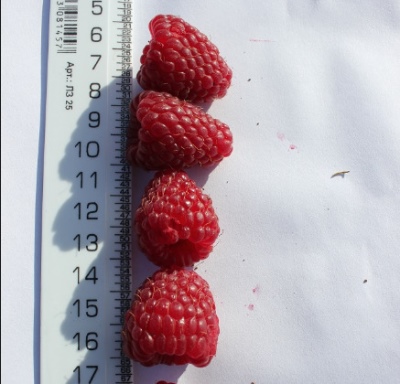
- Authors: breeding nursery Shkolny Sad, V.A. Shiblev
- Repairability: Yes
- Berry color: red
- Taste: sweet
- Ripening period: early
- Berry weight, g: up to 12
- Frost resistance: resistant to light frost
- Drop off location: southern slopes, protected from northerly winds by buildings or a fence
- Fruiting period: from mid-July to late autumn
- Keeping quality: Yes
Any summer resident seeks to plant fruit plants that are not too demanding in care on their site, which will delight with an enviable harvest every season. Early large-fruited raspberries The Little Humpbacked Horse is a real find for the garden.
Description of the variety
The Little Humpbacked Horse was bred relatively recently by the outstanding scientist V. A. Shiblev in the Shkolny Sad kennel. In 2018, agriculture began to undergo state tests for uniformity, distinctness and stability. In 2020, a selection novelty appeared in many nurseries and specialized stores. Experienced gardeners have already appreciated its special properties.
Ripening terms
Early variety. You can enjoy the first fruits in mid-July. Ripening continues until late autumn.
Yield
The yield is very high. In the first year, you can get up to 1.5 t / ha. On the second - 10 t / ha. On the third - 20 t / ha. At least 2 crops are harvested per season. The harvested berries retain their presentation well even with prolonged storage, freezing and transportation.
Berries and their taste
Raspberry pleases with rather large fruits. The berry weighs up to 12 g. The fruits are characterized by an unusual sweet taste, rich red color and oval shape. On the bush, they ripen in clusters with several large berries.

Growing features
To cultivate raspberries the Little Humpbacked Horse, you do not need special knowledge and skills. The repairing variety is easy to care for. But some nuances should be taken into account.
There is no need to use the trellis disembarkation method. Bushes are compact, low, no more than 100 cm. Weakly spiked. Only the lower part is studded, the upper and middle part with fewer spines. Leaves are dark green, slightly drooping, corrugated.
Be sure to carry out pre-winter work. Low winter hardiness. Before the onset of frost, dried and broken stems are removed on the site, biomaterial is embedded in the soil and watered abundantly. At the first frost, the bushes are bent down, fixed and covered with warm, dense material. You can also carry out a complete pruning of the shoots, then it is enough to carry out mulching, which protects the roots from the cold.
Raspberries are characterized by thickening. If you do not control the amount of shoots released, then in a fairly short time the plants can severely clog the area.
The soil should be moist, but without stagnant water. Watering is moderate, which is increased during flowering and fruiting. It is necessary to saturate the soil with moisture abundantly only after planting seedlings and in the fall, before wintering.
The variety responds positively to organic fertilizing (mullein, bird droppings), which are introduced in the spring. Young seedlings are not fed with mineral fertilizers. Such additional nutrition is required only for old bushes (from 4 years old).
Site selection and soil preparation
The culture prefers fertile soils (sandy loam or loam). It is important to control the pH level, which should be neutral. Alkalization or acidification of the soil adversely affects fruiting and plant health.
A place for planting is chosen sunny, protected from drafts and stagnant water. The site is preliminarily cleared of weeds and debris. Mineral (superphosphate, potash) and organic (humus, ash) fertilizers are introduced. Be sure to loosen the soil with this composition and dig it up.






Diseases and pests
The Little Humpbacked Horse has a pretty good immunity to many diseases. But it weakly resists such dangerous fungal infections as purple spot and anthracnose. The first can develop due to the excessive amount of nitrogen in the soil. The second is due to an increase in soil acidity or a large amount of moisture in the spring.

Unfortunately, raspberries, like other plants, do not bypass various diseases and pests. Only armed with the knowledge and the necessary means for this, you can cope with such troubles. To help the plant, it is very important to be able to recognize the disease in time and begin timely treatment.
Reproduction
You can lay a new raspberry tree in both autumn and spring. If a spring planting is carried out, the plant will still yield. However, the best time is autumn, there will be more time for rooting and full development.
The Little Humpbacked Horse is propagated in several ways. The first way is grafting. To obtain cuttings, pruning is done in the fall. Then they are added dropwise, wrapped in foil and periodically watering.
The second breeding method is by basal shoots.Here it is enough to separate the roots with a shovel.
It should be noted that the variety is distinguished by its great shoot substitution, so the summer resident will never have problems obtaining planting material.
Seedlings are chosen with a well-developed root system, the stems are cut to 30 cm, on which there should be 3-4 buds. The root collar must be left above the surface, it cannot be added dropwise. This will lead to decay.
Planting material is planted at a distance of 0.5-1 m between bushes and 1-1.5 m between rows. The depth of the hole is 10-15 cm. After planting raspberries in the area, the soil around the bush is tamped, watered abundantly and mulched.








































































